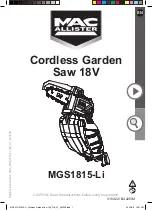
12
a)
Maintain a firm grip on the saw and position your
arms to resist kickback forces. Position your body
to either side of the blade, but not in line with
the blade. Kickback could cause the saw to jump
backwards, but kickback forces can be controlled by
the operator, if proper precautions are taken.
b)
When blade is binding, or when interrupting a cut
for any reason, release the trigger and hold the saw
motionless in the material until the blade comes
to a complete stop. Never attempt to remove the
saw from the work or pull the saw backward while
the blade is in motion or kickback may occur.
Investigate and take corrective actions to eliminate the
cause of blade binding.
c)
When restarting a saw in the workpiece, centre the
saw blade in the kerf and check that saw teeth are
not engaged into the material. If saw blade is binding,
it may walk up or kickback from the workpiece as the
saw is restarted.
d)
Support large panels to minimise the risk of blade
pinching and kickback. Large panels tend to sag
under their own weight. Supports must be placed
under the panel on both sides, near the line of cut and
near the edge of the panel.
e)
Do not use dull or damaged blades. Unsharpened
or improperly set blades produce narrow kerf causing
excessive friction, blade binding and kickback.
f)
Blade depth and bevel adjusting locking levers
must be tight and secure before making cut. If blade
adjustment shifts while cutting, it may cause binding
and kickback.
g)
Use extra caution when sawing into existing walls
or other blind areas. The protruding blade may cut
objects that can cause kickback.
SAFETY INSTRUCTIONS FOR PLUNGE TYPE SAWS
GUARD FUNCTION
a)
Check guard for proper closing before each use.
Do not operate the saw if guard does not move
freely and enclose the blade instantly. Never clamp
or tie the guard so that the blade is exposed. If saw
is accidentally dropped, guard may be bent. Check to
make sure that guard moves freely and does not touch
the blade or any other part, in all angles and depths of
cut.
b)
Check the operation and condition of the guard
return spring. If the guard and the spring are not
operating properly, they must be serviced before
use. Guard may operate sluggishly due to damaged
parts, gummy deposits, or a build-up of debris.
c)
Assure that the base plate of the saw will not shift
while performing the “plunge cut” when the blade
bevel setting is not at 90°. Blade shifting sideways
will cause binding and likely kick back.
d)
Always observe that the guard is covering the
blade before placing saw down on bench or floor.
An unprotected, coasting blade will cause the saw to
walk backwards, cutting whatever is in its path. Be
aware of the time it takes for the blade to stop after
switch is released.
SAFETY INSTRUCTIONS FOR DIAMOND CUTTING-
OFF OPERATION
a)
The guard provided with the tool must be securely
attached to the power tool and positioned for
maximum safety, so the least amount of wheel is
exposed towards the operator. Position yourself
and bystanders away from the plane of the rotating
wheel. The guard helps to protect operator from broken
wheel fragments and accidental contact with wheel.
650W Mini circular saw_MNL_EMCS650_TPS_GB_V02_V20518_20180604.indd 12
6/4/18 09:20













































